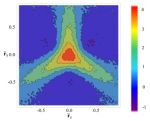EPJ B Highlight - Taking advantage of graphene defects
- Details
- Published on 23 September 2014

New theoretical model of the effect of triangular defects in graphene provides numerical estimates of the resulting current rectification with potential applications in security screening.
Electronic transport in graphene contributes to its characteristics. Now, a Russian scientist is proposing a new theoretical approach to describe graphene with defects—in the form of artificial triangular holes—resulting in the rectification of the electric current within the material. Specifically, the study provides an analytical and numerical theory of the so-called ratchet effect —which results in a direct current under the action of an oscillating electric field, due to the skew scattering of electronic carriers by coherently oriented defects in the material. These findings are published in EPJ B by Sergei Koniakhin from the Ioffe Physical-Technical Institute and the Academic University - Nanotechnology Research and Education Centre, both affiliated with the Russian Academy of Sciences in St. Petersburg.
The author studied the scattering on various types of triangular defects, including the scattering on a cluster in the shape of a solid triangle. To do so, Koniakhin used a theoretical framework ranging from the scale of the graphene sample – the so-called classical framework—to the atomic level, at the quantum mechanical scale. The study also focuses on the example of scattering on three- point defects placed at the corners of a triangle. The author analysed symmetric and asymmetric parts of scattering rates of electrons and implemented it into the classical Boltzmann kinetic theory.
The numerical estimation of the current rectification effect resulting from this work has yet to be confirmed experimentally. However the numerical values obtained can directly be compared with future experimental data. Such theoretical studies of graphene with triangular defects could be used in the detection of terahertz radiation, which has applications in security screening detectors. These are based on the photogalvanic effect, which is the appearance of electric current as result of irradiation of a device or sample material by light.
S.V. Koniakhin (2014), Ratchet effect in graphene with trigonal clusters, European Physical Journal B, DOI: 10.1140/epjb/e2014-50434-4




